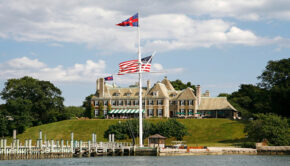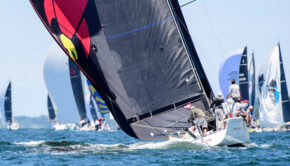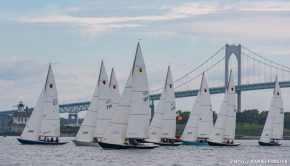Kiwi invasion for 169th Annual Regatta
Published on June 11th, 2023
Howard Spencer surprised more than a few people in 2022 by flying with his crew from New Zealand, stepping onto an IC37 for the first time and winning his class debut in the Round the Island Race that traditionally kicks off the New York Yacht Club Annual Regatta. A respectable seventh, of 20, in the two-day weekend series that followed proved the initial victory wasn’t a fluke.
This year on June 9-11, Spencer and his Menace team doubled up on first-place trophies, winning Friday’s shortened Round the Island Race and then taking the weekend Annual Regatta series as well.
“It’s a long way from the other side of the world,” says Spencer. “[In the IC37 class] you have a better than fair chance of winning, the boats are pretty even—which is what you want in a one-design class. Being able to roll in here, pick up a boat, put some new sails on it and be competitive is fantastic.”
After four solid races, Menace started the final race with a one-point lead over Steve Liebel’s New Wave and a five-point lead over Peter McClennen’s Gamecock. Both teams have tasted success in this class in the past. Covering one good team with the regatta on the line is a tall order, covering two can often be impossible.
“The last race today was the most terrific race,” he says. “We got there somehow, we had two boats close behind [in the overall standings] and, trying to keep those two boats behind us, [tactician] Chris Steele did a great job there.”
After starting the weekend series with a win, New York Yacht Club Commodore Paul Zabetakis and his Swan 42 team on Impetuous saw things turn for the worse in the second race in the 10-boat ORC C division.
“We had a bad race,” he says. “We had a bad start and, basically, we were in last place.”
Zabetakis and much of his team have sailed together for a decade or more and have weathered plenty of storms, literally and figuratively. No one likes to look up shortly after the start and see a fleet of transoms. But it happens to everyone at some point. How a team responds to the adversity is what really counts.
“We clawed ourselves back to fifth, which I think saved the regatta,” says Zabetakis of their overall win, assisted by a solid final day. “We were third coming in (to the final day). We had two really good starts, and it got us out in good lanes so we were able to finish second and then first.”
It’s something that Zabetakis says he’s seen before—his team rebounding from a poor race and winning the regatta on the final day. He attributes his team’s resiliency to the fact that they all really enjoy sailing together.
“We found this thing that’s almost a pattern,” he says. “If we don’t do well on a Saturday, then on Sundays we sort of come back. I think the team just gels, and we buckle down and get it done. I have a lot of fun with the team, everybody knows what to do. It’s just amazing to watch them. They work well together; they like each other, and I think that’s the secret.”
In the 14-boat Shields class, John Burnham and Reed Baer’s Grace trailed Clay Deutsch’s Tinky by four points coming into the final day, but finished no lower than third in each of the final four races for the win.
“He finished right behind us in the first race (on the final day), but there were no throw outs in this regatta, and he had a bad race and suddenly were ahead or maybe we were even going into the third race, then he had another tough race.”
When all was said and done, Grace had turned a four-point deficit into a 15-point lead, easily the biggest margin of victory across the regatta.
What the 12-Metre Modern class lacked in numbers, it made up for in star power. Among the four entries were two former America’s Cup-winning yachts and some of the top professional sailors in the world.
Peter Askew’s Enterprise team was the class of this elite group, winning Friday’s Round the Island Race and then taking the first three races of the weekend series before showing a hint of mortality with a second in the regatta’s final race. Takashi Okura’s Freedom team, which included America’s Cup legends Murray Jones and Grant Simmer in the afterguard, was second.
Sailing the heavy, historic 12 Metres represents a significant course change for Askew, who until a few years ago was involved with his brother David in an ocean-racing campaign onboard a terrifically fast Volvo 70. A short race was measured in hundreds of miles.
“[Sailing 12 Metres] kind of takes me back to how I learned how to sail as a kid, things were a lot slower and moved a bit differently back then,” he says. “We got together with some of the guys I’ve been sailing with regularly and put a team together and started to develop the boat. We made some changes, it’s been very fun. It’s very technical and I like that part of it.”
The true test for both teams will come later this summer as the 12 Metre class will host its World Championship in July in Newport. Askew and his Enterprise team has won the initial battle, but the Freedom team will be gunning for revenge in a little over a month.
Event information – Race details – Facebook
The New York Yacht Club’s Annual Regatta was first sailed on the Hudson River on July 16 and 18, 1846. A similar competition the previous year was called a Trial of Speed. With a few exceptions for world wars and other global crises, the event has been held every year since. For the majority of its existence, the Annual Regatta was raced on waters close to New York City. Since 1988, however, the event has been sailed out of the Harbour Court clubhouse in Newport, R.I., and has settled into the current three-day format, which includes a race around Conanicut Island on Friday, two days of buoy or navigator-course racing on Saturday and Sunday and nightly social activities on the grounds of the historic Harbour Court mansion.
Source: NYYC









 We’ll keep your information safe.
We’ll keep your information safe.